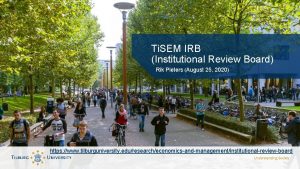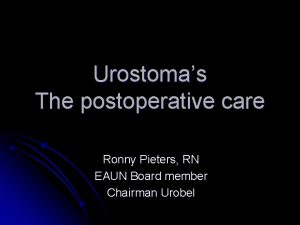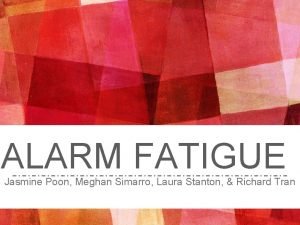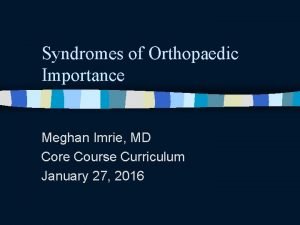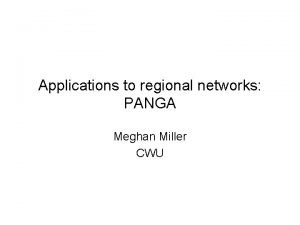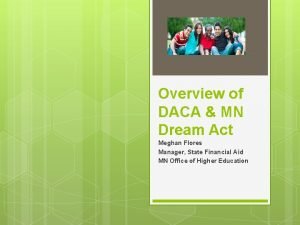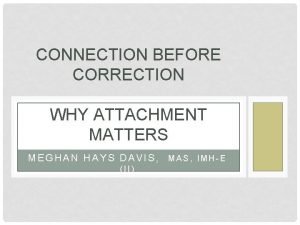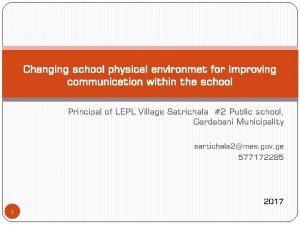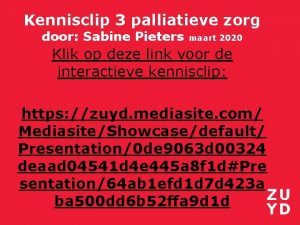Optimal Educational Environmet Part 2 Meghan Pieters Dr













- Slides: 13

Optimal Educational Environmet Part 2 Meghan Pieters Dr. Brian Stark EDU 520 Education and the Law September 7, 2014

Welcome Parents! It is my goal to create an optimal educational environment for your children. �An optimal educational environment has a plan for addressing: �Violence �Constitutional protections and freedoms of students and teachers �Classroom safety �Needs of students who do not speak English well

Violence �School violence is violence between youths that happens on school property (Centers for Disease Control and Prevention, 2012). �Ways to address violence �Set expectations using CHAMPS �Utilize Restorative Practices

CHAMPS � One way to reduce violence in the classroom is to utilize the CHAMPS behavior management system. With the use of CHAMPS, “the teacher's goal is to teach students directly how to be successful in specific class situations (Manis, 2012). ” � C- Conversation Can students talk during this activity? � H- Help How can students ask for help? � A- Activity What is the expected end result of the activity? � M- Movement Can students move around the classroom? � P- Participation What behavior would show good participation? � S- SUCCESS!!! � CHAMPS is an evidence-based approach to classroom behavior management (Rodriguez, 2014). � CHAMPS is based on more than 30 years of research (Rodriguez, 2014). � Improvements observed in classrooms include � Reductions in classroom disruptions (Rodriguez, 2014) � Reductions in office referrals (Rodriguez, 2014) � Reductions in both in-school and out-of school suspensions (Rodriguez, 2014)

Restorative Practices �One step that can be taken to address violence in the classroom is to utilize restorative practices techniques (IIRP Graduate School, 2012). �“Restorative practices is a social science that studies how to build social capital and achieve social discipline through participatory learning and decision-making (IIRP Graduate School, 2012). ” �Data shows that use of restorative practices �Reduces crime, violence, and bullying (IIRP Graduate School, 2012) �Improves human behavior (IIRP Graduate School, 2012) �Repairs harms (IIRP Graduate School, 2012)

Constitutional Protections and Freedoms of Students and Teachers � Students � Freedom of expression � write for school newspaper, join clubs, distribute literature, and petition school officials (Hudson, 2002) � Protection against unreasonable search and seizure � must have reasonable suspicion (Ehlenberger, 2001) � Due Process � student accused of wrongdoing has right to tell side of the story (American Civil Liberties Union of Vermont, 2014). � Teachers � Freedom of expression � expression and speech that does not create material disruption to the educational interest of the district (Essex, 2012) � Right to privacy � right to privacy in their personal lives as long as they do not violate the integrity of the community (Essex, 2012) � Freedom of association � right to associate with other individuals of their choice without the risk of punishment (Essex, 2012).

Classroom Safety � Parents, school staff, and other adults in the community can help kids prevent bullying by � talking about it (U. S. Department of Health and Human Services) � building a safe school environment (U. S. Department of Health and Human Services) � creating a community-wide bullying prevention strategy (U. S. Department of Health and Human Services) � Classrooms can work together to create � a code of conduct (U. S. Department of Health and Human Services) � classroom rules (U. S. Department of Health and Human Services) � a bullying reporting system (U. S. Department of Health and Human Services). � Classrooms who have implemented similar strategies have documented a decreased number of students who have observed � physical bullying (Bullying Prevention Program, 2014) � others being ignored, rejected, or lied about (Bullying Prevention Program, 2014) � teasing (Bullying Prevention Program, 2014)

Meet the Needs of Students Who Do Not Speak English Well �Create a language rich environment (Robertson, 2009) � access to books and reference materials, posters, labels, student work, and as much print and language as possible (Robertson, 2009) �Simplify your language (Robertson, 2009) � avoid slang, speak clearly and naturally, and encourage students to ask for clarification when they do not understand the meaning of a word (Robertson, 2009) �Support academic language development (Robertson, 2009) � preview texts, teach grammatical structures relevant to the content area, and show targeted academic language is used in different subject areas (Robertson, 2009) �Utilize cooperative learning (Robertson, 2009) � working together on a worksheet, think-pair-share, and book groups (Robertson, 2009).

Parent Survey �You were given a copy of this survey. Put a check next to everything you would like to see in your child’s classroom. � Reductions in classroom disruptions � Reductions in the number of office referrals � Reductions in both in-school and out-of school suspensions � Increase in efficacy and student motivation � Reduction in crime, violence, and bullying � Improvement in human behavior and repairing harms � Constitutional protections for students and teachers including freedom of expression, protection against unreasonable search and seizure, due process, right to privacy, and freedom of association � Reductions in bullying and teasing � A plan for helping students who do not speak English well

My Responses �Put a check next to everything you would like to see in your child’s classroom √ Reductions in classroom disruptions √ Reductions in the number of office referrals √ Reductions in both in-school and out-of school suspensions √ Increase in efficacy and student motivation √ Reduction in crime, violence, and bullying √ Improvement in human behavior and repairing harms √ Constitutional protections for students and teachers including freedom of expression, protection against unreasonable search and seizure, due process, right to privacy, and freedom of association √ Reductions in bullying and teasing √ A plan for helping students who do not speak English well

If your responses look similar to mine, then we can achieve this together through: �CHAMPS �Restorative Practices �Protecting student and teacher Constitutional rights and freedoms �Creating a plan for classroom safety and bullying �Implementing techniques to address the needs of students who do not speak English well

With your support, we can achieve the same success as the classrooms described in this presentation!

References American Civil Liberties Union of Vermont. (2014). Students’ Rights—Due Process and Discipline. Retrieved from https: //acluvt. org/pubs/students_rights/due_process. phpto-Search -Students. aspx Bullying Prevention Program. (2014). Program Effectiveness Data. Retrieved from https: //www. bullyfree. com/school-program/program-effectiveness-data Centers for Disease Control and Prevention. (2012). Understanding School Violence. Retrieved from http: //www. cdc. gov/violenceprevention/pdf/schoolviolence_factsheet-a. pdf Ehlenberger, Kate R. (2001). The Right to Search Students. Retrieved from http: //www. ascd. org/publications/educational-leadership/dec 01/vol 59/num 04/The-Right-to-Search. Students. aspx Essex, N. L. (2012). School law and the public schools: A practical guide for educational leaders. (5 th ed. ). Boston, MA: Allyn & Bacon. Hudson, David L. (2002). K-12 public school student expression overview. Retrieved from http: //www. firstamendmentcenter. org/k-12 -public-school-student-expression-overview IIRP Graduate School. (2012). What is Restorative Practices? Retrieved from http: //www. iirp. edu/what-is-restorative-practices. php#overview Manis, Chad. (2012). CHAMPS Classroom Management: Teach Students How to be Successful in Class. Retrieved from http: //www. dailyteachingtools. com/champs-classroommanagement. html Robertson, Kristina. (2009). Supporting ELLs in the Mainstream Classroom: Language Tips. Retrieved from http: //www. colorincolorado. org/article/33047/ Rodriguez, Billie J. (2014). Is CHAMPS Evidence Based? Retrieved from http: //www. safeandcivilschools. com/research/references/is-champs-evidence-based. pdf U. S. Department of Health and Human Services. Prevent Bullying. Retrieved from http: //www. stopbullying. gov/prevention/
